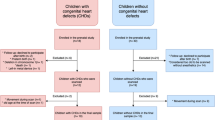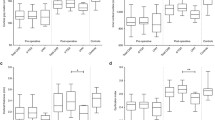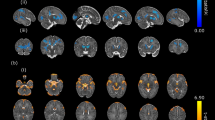Abstract
Infants with congenital heart disease (CHD) have delayed brain maturation and alterations in brain volume. Brain metrics is a simple measurement technique that can be used to evaluate brain growth. This study used brain metrics to test the hypothesis that alterations in brain size persist at 3 months of age and that infants with CHD have slower rates of brain growth than control infants. Fifty-seven infants with CHD underwent serial brain magnetic resonance imaging (MRI). To evaluate brain growth across the first 3 months of life, brain metrics were undertaken using 19 tissue and fluid spaces shown on MRIs performed before surgery and again at 3 months of age. Before surgery, infants with CHD have smaller frontal, parietal, cerebellar, and brain stem measures (p < 0.001). At 3 months of age, alterations persisted in all measures except the cerebellum. There was no difference between control and CHD infants in brain growth. However, the cerebellum trended toward greater growth in infants with CHD. Somatic growth was the primary factor that related to brain growth. Presence of focal white matter lesions before and after surgery did not relate to alterations in brain size or growth. Although infants with CHD have persistent alterations in brain size at 3 months of age, rates of brain growth are similar to that of healthy term infants. Somatic growth was the primary predictor of brain growth, emphasizing the importance of optimal weight gain in this population.

Similar content being viewed by others
Abbreviations
- RFH:
-
Right frontal height
- LFH:
-
Left frontal height
- RFL:
-
Right frontal length
- LFL:
-
Left frontal length
- BIFD:
-
Bifrontal diameter
- BoBPD:
-
Bone biparietal diameter
- BrBPD:
-
Brain biparietal diameter
- TCD:
-
Transverse cerebellar diameter
- BA:
-
Brainstem area
References
Almli CR, Rivkin MJ, McKinstry RC (2007) The NIH MRI study of normal brain development (objective-2): newborns, infants, toddlers, and preschoolers. Neuroimage 35(1):308–325
Beca J, Gunn J, Coleman L, Hope A, Whelan LC, Gentles T et al (2009) Pre-operative brain injury in newborn infants with transposition of the great arteries occurs at rates similar to other complex congenital heart disease and is not related to balloon atrial septostomy. J Am Coll Cardiol 53(19):1807–1811
Bellinger DC, Wypij D, duPlessis AJ, Rappaport LA, Jonas RA, Wernovsky G et al (2003) Neurodevelopmental status at eight years in children with dextro-transposition of the great arteries: The Boston Circulatory Arrest Trial. J Thorac Cardiovasc Surg 126(5):1385–1396
Bellinger DC, Newburger JW, Wypij D, Kuban KC, duPlesssis AJ, Rappaport LA (2009) Behaviour at eight years in children with surgically corrected transposition: The Boston Circulatory Arrest Trial. Cardiol Young 19(1):86–97
Cheung MM, Davis AM, Wilkinson JL, Weintraub RG (2003) Long term somatic growth after repair of tetralogy of Fallot: evidence for restoration of genetic growth potential. Heart 89(11):1340–1343
Clancy RR, McGaurn SA, Wernovsky G, Spray TL, Norwood WI, Jacobs ML et al (2000) Preoperative risk-of-death prediction model in heart surgery with deep hypothermic circulatory arrest in the neonate. J Thorac Cardiovasc Surg 119(2):347–357
Connors JM, O’Callaghan MJ, Burns YR, Gray PH, Tudehope DI, Mohay H et al (1999) The influence of growth on development outcome in extremely low birthweight infants at 2 years of age. J Paediatr Child Health 35(1):37–41
Ehrenkranz RA, Dusick AM, Vohr BR, Wright LL, Wrage LA, Poole WK (2006) Growth in the neonatal intensive care unit influences neurodevelopmental and growth outcomes of extremely low birth weight infants. Pediatrics 117(4):1253–1261
Franz AR, Pohlandt F, Bode H, Mihatsch WA, Sander S, Kron M et al (2009) Intrauterine, early neonatal, and postdischarge growth and neurodevelopmental outcome at 5.4 years in extremely preterm infants after intensive neonatal nutritional support. Pediatrics 123(1):e101–e109
Garel C (2004) MRI of the fetal brain. Springer, Berlin
Garel C, Chantrel E, Elmaleh M, Brisse H, Sebag G (2003) Fetal MRI: normal gestational landmarks for cerebral biometry, gyration and myelination. Childs Nerv Syst 19(7–8):422–425
Hack M, Breslau N, Weissman B, Aram D, Klein N, Borawski E (1991) Effect of very low birth weight and subnormal head size on cognitive abilities at school age. N Engl J Med 325(4):231–237
Inder TE, Wells SJ, Mogridge NB, Spencer C, Volpe JJ (2003) Defining the nature of the cerebral abnormalities in the premature infant: a qualitative magnetic resonance imaging study. J Pediatr 143(2):171–179
Licht DJ, Shera DM, Clancy RR, Wernovsky G, Montenegro LM, Nicolson SC et al (2009) Brain maturation is delayed in infants with complex congenital heart defects. J Thorac Cardiovasc Surg 137(3):529–536 discussion 536–537
Limperopoulos C, Majnemer A, Shevell MI, Rosenblatt B, Rohlicek C, Tchervenkov C (1999) Neurologic status of newborns with congenital heart defects before open heart surgery. Pediatrics 103(2):402–408
Limperopoulos C, Majnemer A, Shevell MI, Rosenblatt B, Rohlicek C, Tchervenkov C (2000) Neurodevelopmental status of newborns and infants with congenital heart defects before and after open heart surgery. J Pediatr 137(5):638–645
Limperopoulos C, Soul JS, Gauvreau K, Huppi PS, Warfield SK, Bassan H et al (2005) Late gestation cerebellar growth is rapid and impeded by premature birth. Pediatrics 115(3):688–695
Limperopoulos C, Tworetzky W, McElhinney DB, Newburger JW, Brown DW, Robertson RL Jr et al (2010) Brain volume and metabolism in fetuses with congenital heart disease: evaluation with quantitative magnetic resonance imaging and spectroscopy. Circulation 121(1):26–33
Mahle WT, Tavani F, Zimmerman RA, Nicolson SC, Galli KK, Gaynor JW et al (2002) An MRI study of neurological injury before and after congenital heart surgery. Circulation 106(12 Suppl 1):I109–I114
Majnemer A, Limperopoulos C, Shevell M, Rohlicek C, Rosenblatt B, Tchervenkov C (2008) Developmental and functional outcomes at school entry in children with congenital heart defects. J Pediatr 153(1):55–60
McQuillen PS, Barkovich AJ, Hamrick SE, Perez M, Ward P, Glidden DV et al (2007) Temporal and anatomic risk profile of brain injury with neonatal repair of congenital heart defects. Stroke 38(Suppl 2):736–741
Miller SP, McQuillen PS, Hamrick S, Xu D, Glidden DV, Charlton N et al (2007) Abnormal brain development in newborns with congenital heart disease. N Engl J Med 357(19):1928–1938
Nguyen The Tich S, Anderson PJ, Shimony JS, Hunt RW, Doyle LW et al (2009) A novel quantitative simple brain metric using MR imaging for preterm infants. AJNR Am J Neuroradiol 30(1):125–131
Sarajuuri A, Jokinen E, Puosi R, Eronen M, Mildh L, Mattila I et al (2007) Neurodevelopmental and neuroradiologic outcomes in patients with univentricular heart aged 5 to 7 years: related risk factor analysis. J Thorac Cardiovasc Surg 133(6):1524–1532
Srinivasan L, Allsop J, Counsell SJ, Boardman JP, Edwards AD, Rutherford M (2006) Smaller cerebellar volumes in very preterm infants at term-equivalent age are associated with the presence of supratentorial lesions. AJNR Am J Neuroradiol 27(3):573–579
Srinivasan C, Jaquiss RD, Morrow WR, Frazier EA, Martin D, Imamura M et al (2010) Impact of staged palliation on somatic growth in patients with hypoplastic left heart syndrome. Congenit Heart Dis 5(6):546–551
Tich SN, Anderson PJ, Hunt RW, Lee KJ, Doyle LW, Inder TE (2011) Neurodevelopmental and perinatal correlates of simple brain metrics in very preterm infants. Arch Pediatr Adolesc Med 165(3):216–222
Watanabe K, Matsui M, Matsuzawa J, Tanaka C, Noguchi K, Yoshimura N et al (2009) Impaired neuroanatomic development in infants with congenital heart disease. J Thorac Cardiovasc Surg 137(1):146–153
Welke KF, Shen I, Ungerleider RM (2006) Current assessment of mortality rates in congenital cardiac surgery. Ann Thorac Surg 82(1):164–170 discussion 170–171
Wypij D, Newburger JW, Rappaport LA, duPlessis AJ, Jonas RA, Wernovsky G et al (2003) The effect of duration of deep hypothermic circulatory arrest in infant heart surgery on late neurodevelopment: The Boston Circulatory Arrest Trial. J Thorac Cardiovasc Surg 126(5):1397–1403
Acknowledgments
This research was supported by grants from the National Heart Foundation of New Zealand; the Green Lane Research and Education Fund; the Auckland Medical Research Fund; the Doris Duke Distinguished Clinical Scientist Award; the National Institutes of Health (NIH) under Ruth L. Kirschstein National Research Service Award no. T32 HD043010; and the Clinical and Translational Science Awards no. UL1RR024992 and P30HD062171 from the Eunice Kennedy Shriver National Institute of Child Health and Human Development. Data used in the preparation of this article were obtained from the NIH Pediatric MRI Data Repository created by the NIH MRI Study of Normal Brain Development. This is a multisite, longitudinal study of typically developing children from ages newborn through young adulthood conducted by the Brain Development Cooperative Group and supported by the National Institute of Child Health and Human Development, the National Institute on Drug Abuse, the National Institute of Mental Health, and the National Institute of Neurological Disorders and Stroke (Contracts no. N01-HD02-3343; N01-MH9-0002; and N01-NS-9-2314, -2315, -2316, -2317, -2319, and -2320). A listing of the participating sites and a complete listing of the study investigators can be found at http://www.bic.mni.mcgill.ca/nihpd/info/participating_centers.html. This manuscript reflects the view of the authors and may not reflect the opinions or views of the NIH. The authors acknowledge the contributions of the study research nurses, in particular Laura-Clare Whelan, for their assistance with data collection, and the cardiac surgeons, cardiologists, anesthetists, perfusionists, and pediatric intensive care staff at Starship Children’s Hospital for their support of our study. Most importantly, we are thankful to the families who allowed their babies to participate in this study.
Author information
Authors and Affiliations
Corresponding author
Rights and permissions
About this article
Cite this article
Ortinau, C., Inder, T., Lambeth, J. et al. Congenital Heart Disease Affects Cerebral Size but Not Brain Growth. Pediatr Cardiol 33, 1138–1146 (2012). https://doi.org/10.1007/s00246-012-0269-9
Received:
Accepted:
Published:
Issue Date:
DOI: https://doi.org/10.1007/s00246-012-0269-9




